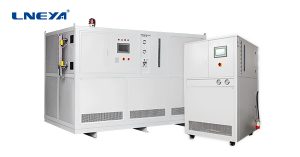Pourquoi y a-t-il un phénomène de gel dans le circulateur du refroidisseur à basse température ?
Many refroidisseur à basse température circulators will frost when they are used, but there is no frost phenomenon in refroidisseur à basse température circulators. So, what’s the matter? Is it related to refrigeration?
First of all, why does the refroidisseur à basse température circulator frost? To find out why there is no frost in the refroidisseur à basse température circulator, it’s better to see why the the refroidisseur à basse température circulator frosts first. Frost is a white crystalline substance of water vapor. When water vapor suddenly encounters a very low temperature object, it will condense frost on its surface.
When the air in the the refroidisseur à basse température circulator meets the inner wall of the the refroidisseur à basse température circulator with lower temperature, it will form frost on its surface. This is the basic reason for the frost in the the refroidisseur à basse température circulator. The frosting of the the refroidisseur à basse température circulator will affect the efficiency of heat exchange, resulting in the decrease of refrigeration capacity, which requires manual removal by users.
Knowing why the cold water cooler circulator frosts, then why not the wind-cooled frost? Is it the opposite? The principle of air-cooled ultra-refroidisseur à basse température circulator is to use air to refrigerate. High temperature air flows through the built-in evaporator. Because of the high air temperature and the low evaporator temperature, the air temperature will be reduced by the direct heat exchange between the two.
At the same time, the cold air is blown into the ultra-low temperature water cooler circulator. The air-cooled ultra-low temperature water cooler circulator reduces the temperature of the ultra-low temperature water cooler circulator through this continuous circulation mode. However, there is always water vapor in the air. When water vapor is cooled, it will condense. So as long as there is heat exchange in the cryogenic water cooler circulator, frost will form. So where did the frost go?
In fact, the air-cooled ultra-low temperature water cooler circulator is not frost-free, but frost condensed on the evaporator. Because it is inside the cryogenic water cooler circulator, we can’t see it directly when we open the door of the cryogenic water cooler circulator, so it is called frost-free.
Recommandations connexes
-
LNEYA chip test temperature control system operation overview
1424With the development of technology, chip testing has a very high requirement for its accuracy under certain temperature requirements. So what is the understanding of the chip test system? Chip testing requires high temperature accuracy in low temp...
Voir les détails -
Introduction du système d'essai de température des semi-conducteurs LNEYA
1235Le système d'essai de température des semi-conducteurs est un élément indispensable du processus de fabrication des semi-conducteurs. Le système de test de température des semi-conducteurs LNEYA est dédié à divers tests de semi-conducteurs. Le système de test de température des semi-conducteurs passe par le...
Voir les détails -
How to solve the problem of insufficient cooling capacity of semiconductor cooling cycle system?
1319The semiconductor cooling cycle system is a device for cooling the semiconductor heating part. LushiA reminds that if the cooling capacity is insufficient during the operation, it is necessary to check in time to see if something has gone wrong. W...
Voir les détails -
Performance Test of Household Refrigerator Designed by Environmental Chamber Sales
1326Many performance items of household refrigerators are tested under a specific environmental condition. The thermal condition of the air distribution in the environmental chamber is more severe than that in the general artificial constant temperatu...
Voir les détails
 LNEYA Industrial Chillers Fabricant Fournisseur
LNEYA Industrial Chillers Fabricant Fournisseur












